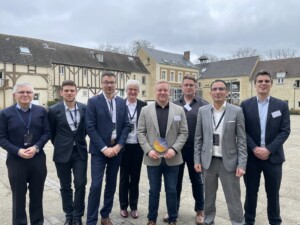Process research for more sustainable kaolin calcination
The goal of the MONICALC innovation project was to improve the process of calcination while increasing both energy efficiency and use of renewable energy sources. The project brought together six partners and aimed to demonstrate the feasibility of the controlled use of diversified energy in calcination.
Cooperation for an integrated monitoring system and advanced process control
MONICALC project worked on developing a kaolin production process that ensured high quality while reducing energy use required the expertise and close cooperation of all the partners in the consortium. Imerys, the world’s largest kaolin producer, provided the industrial-scale plant for testing and implementing the MONICALC process.
French software company Predict developed an integrated monitoring system that receives data from multiple sources during the production process, including the distributed control system, online sensors, and lab analytic measurements. Collecting and consolidating data from the whole production chain meant that bottlenecks and disturbances could be identified at an early stage.
Finland’s Aalto University, together with Imerys, developed an off-line prototype for an advanced control system for the multiple-hearth furnace calciner. This control system is key as it has the potential to optimise the operational condition of the furnace to reduce energy consumption, increase plant capacity, and to ensure that the product-quality specifications are met.
The demonstration of advanced process control automation, online monitoring capabilities, and data integration was a success and could be used as a tool to help reduce the process’s environmental footprint.
An infrared sensor using advanced evaluation algorithms for instant feedback on product quality was developed by the University of Delft in the Netherlands. The quality parameter of aluminium solubility content is directly calculated from the infrared spectrum measurement values, which could lead to the introduction of an automated system.

The integrated monitoring system and advanced process control that was a result of the project. (Image copyright: Outotec)
The University of Exeter in the UK investigated the optimal scraper configuration of the internal rabble arms in the multiple-hearth furnace, which is key to ensuring better product quality. They built a small-scale model to test the distribution of the material in the different stages, which in turn could be used to predict material flow and residence time.
Cutting the carbon footprint of kaolin production Outotec tested fluidised bed technology for kaolin calcination. Fluidised bed calciners have shown several advantages in other processes, for example, alumina production, in recent decades. The results showed that fluidised bed calcination has significantly lower energy consumption than older technology.
To further reduce the environmental impact of kaolin production, Outotec tested diversified energy sources – in this case, pelletised sewage sludge – to fuel the calcination process. A hot-gas cleaning system was used to prevent tar condensation and the need for further cleaning stages to ensure product quality even with a biomass-based fuel.
Experiments performed at Outotec’s Research Center showed that, depending on the product quality requirements, acceptable quality in the fuel gas can be achieved with gas-cleaning equipment like cyclones and hot electrostatic precipitators, which have the advantage of lower pressure drop and low operating and maintenance costs.
The tests and calculations demonstrate that although a combination of such processes is feasible, it is dependent on the achievable quality of the desired final product. However, this is just the first step towards commercialisation, and there is more work ahead of us.
A promising result with broader implications
The result of the integrated process investigated in the MONICALC project is the potential to increase process efficiency and decrease energy consumption and therefore, the CO2 emissions in kaolin calcination. The products and concepts developed as part of the project can be adapted to produce other minerals as well, which is good news not only for the mining and minerals industry but also for society as a whole.
The results of the project and the great collaboration between project members have encouraged us to want to continue our work in this area. The next step is to assess the cost-benefit of implementation.
Calcined kaolin is an essential industrial mineral used, for example, as a component in paints, coatings, inks, etc. The MONICALC project developed a combined process of calcination and gasification for its production, involving innovative algorithms through mine and lab data. This enables to decrease the overall carbon footprint of the operation dramatically. Furthermore, the process developed by MONICALC will contribute to curbing the kaolin industry’s environmental footprint.
EIT RawMaterials enhanced our project exposure exponentially, namely through advertising us across the field and facilitating networking with key stakeholders. We benefited from the EIT RawMaterials support from day one. Nothing would have been possible without them.
Christian Binder, Director, Process Development Outotec GmbH
Innovation made in Europe
Moreover, the MONICALC project was nominated for the EIT Innovators Award 2019. The EIT Innovators Award recognises teams from the EIT Innovation Communities that develop high-impact products and services for a sustainable future.




